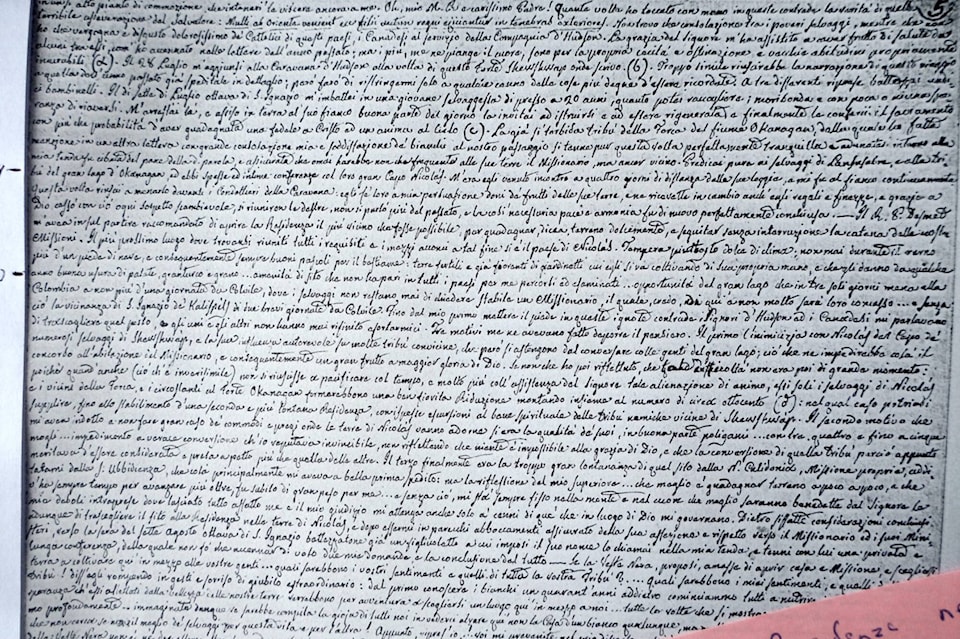Throughout his travels, Jesuit missionary Father Giovanni Nobili was accompanied by a guide, a novice who assisted with the services and an interpreter, who sometimes needed their own interpreter.
Given the language barrier, Nobili’s words often had different meanings than what were intended for the sometimes hundreds of Indigenous people who gathered to hear him. While the missionaries may have thought they were converting pagans to Christians, the Indigenous people often interpreted the prayers and practices in terms of their own spiritual beliefs.
Nobili most often described the “Shoushwap” in complimentary terms, yet he had a far different impression for other nations.
In one entry, he spoke of a concern that Okanagan Chief Nicolás “had threatened to attack Fort Shoushwap and to exterminate the whites.” Consequently, he hurried there from Fort Alexandria in the middle of the winter, to thwart the violence. The chief told him the plans were untrue and then “burst out in angry diatribes and complaints against the Shoushwap…”
Throughout the letters, Nobili hints that some of the negative traits he associated with the Indigenous people were in fact due in part to their association with the fur traders. “The Indians of the Forts are lazier and more frivolous than the others, this is so because they are, so to speak, “better off,” and because of their continuous association with the Hudson’s Company servants, they (the servants) are a thoroughly corrupted lot having come here from Canada in the pursuit of all kinds of licentiousness.” At one point, he remarked how the mind of the Indians “is naturally no less open than that of civilized nations, and that therefore not only it could be cultivated, but perhaps even reach perfection.”
Read more: Column: Missionary letters from 1845-47 reveal historical insights about the Shuswap
Read more: Historic photos, ‘intriguing text’ prompts creation of new book about the Shuswap
Even though Nobili complained about how Hudson’s Bay employees corrupted the Indigenous people, when compared with the situation south of the border, these employees were princes. In one passage, he explained why Indigenous people appreciated the fur traders.
“Generally they are fond of the Members of the Hudson’s Company because they know the advantages and help that they derive from them. And the truth must be said, while the Americans in New California, around Wallamette, and in the whole of the Oregon appear to give as their primary aim the extermination of the poor sauvage” (the French word for wild people).
Throughout the nearly three years that Nobili spent in New Caledonia, he travelled often on horseback between the Okanagan and as far north as Fort St. James and Babine Lake.
In addition to his proselytizing efforts that included erecting giant log crosses, he had many adventures and close calls. One time, his “Canot” (a small boat, likely a canoe) almost capsized when they were crossing the frigid Fraser River with their horses swimming behind them. As a result of his exposure to harsh weather and being forced to survive on meagre rations, his health declined.
Despite having secured land from Chief Nicolás near the head of Okanagan Lake, where a home and Mission were under construction, his superiors decided he must return to Fort Colville as the Jesuits had decided to leave New Caledonia and focus on their work in California.
Nobili then travelled to San Francisco, where he received medical attention and served as an assistant pastor. He founded a Jesuit College in Santa Clara that later became a university.
There, while supervising construction, he stepped on a nail and contracted tetanus, then died at the age of 44 in 1856.
We can only hypothesize why Indigenous people warmly embraced Christianity, as the Nobili letters suggest. Weakened by diseases and with their populations in decline, it is likely many viewed the European religion as a path to salvation as they understood it, because it was part of a culture attached to the European technology that they had also quickly adopted. Another view is that because most Indigenous people were very spiritual by nature, they connected their beliefs with those of the missionaries and thus could accept the Christian teachings as they interpreted them, especially the part about being kind to others.
In more recent times, in a stark reversal from the early days of the missionaries, the goal for many Secwépemc people is to revive their traditions, as it is now obviously clear that Christianity, rather than benefiting their people, was an integral part of the European effort to destroy their culture and their once successful, egalitarian way of life.
newsroom@saobserver.net
Like us on Facebook and follow us on Twitter
